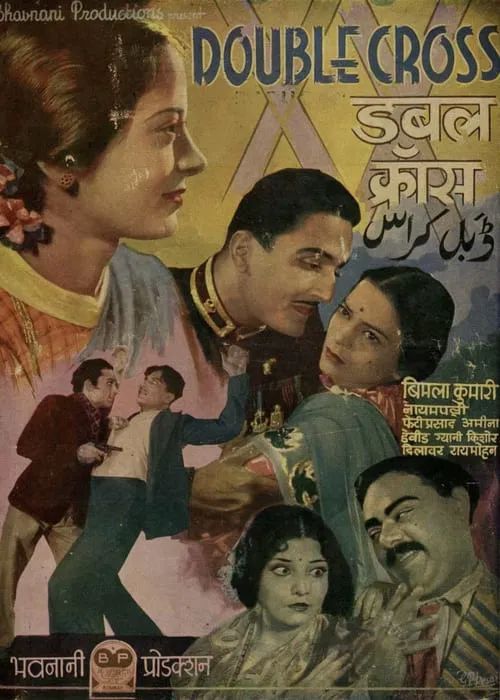Beneath the Glimmer: Unpacking the Intrigue of “Double Cross”
In the glittering, high-stakes world of the 1930s, where traditional power structures clashed with budding modernization, “Double Cross” emerged as a masterful cinematic tapestry of ambition, betrayal, and groundbreaking innovation. Far from being just a period drama, the film delved into the very fabric of societal change, using a brilliant scientific discovery as the unexpected catalyst for a seismic power struggle within the fictional feudal state of Panipur. Let’s pull back the curtain and explore the compelling forces that brought this intricate story to life.
The Vision: Crafting a City of Contradictions
The creative team behind “Double Cross” faced the unique challenge of depicting Panipur not merely as a backdrop, but as a living, breathing character. The script paints a vivid picture of a “swanky, modernized city” deeply rooted in its feudal past – a visual paradox that the production and art departments embraced.

“Our goal was never to merely recreate the 1930s,” explains the film’s director in early interviews. “It was to interpret Panipur’s specific blend of opulence, technological advancement, and lingering traditionalism. We imagined Art Deco architectures merging with indigenous designs, bustling streets where vintage cars drove past grand, ancient palaces. This visual juxtaposition was crucial in highlighting the thematic tension between old money and new innovations.” The costume design further underscored this, meticulously blending contemporary 1930s fashion with subtle nods to classic Indian attire for certain characters, symbolizing their rootedness even in a changing world.
Casting the Chessboard: A Symphony of Antagonism and Intellect
The success of “Double Cross” hinges on its powerful ensemble, with each actor meticulously chosen to embody the complex layers of their characters.
-
David as Prof. Mukherjee: David’s portrayal of the genius inventor, Prof. Mukherjee, was lauded for its nuanced complexity. He brought an intellectual detachment to the role, initially positioning the Professor as a savant removed from worldly ambitions. However, as the narrative progresses, David subtly reveals Mukherjee’s dawning awareness of his invention’s profound, dangerous implications, transforming him from a scientific mind to an unwitting, yet central, player in a high-stakes game. His performance highlights the vulnerability of pure intellect against ruthless power.
-
Romesh Chandra: The casting of a seasoned actor as Romesh Chandra, Prof. Mukherjee’s shrewd stockbroker uncle, was key. This veteran presence conveyed gravitas and the weight of established wealth and influence. The actor masterfully portrayed Chandra’s struggle to maintain his empire, showcasing a character caught between his personal affections (especially for his niece) and the cutthroat demands of finance and politics. His professional alliance with Rangnath was delivered with a subtle camaraderie, grounding their high-stakes business dealings in a sense of mutual respect.
-
Sardar Mulkraj: To embody the cunning and relentless ambition of Sardar Mulkraj, the filmmakers sought an actor capable of projecting menace and strategic brilliance without resorting to caricature. The chosen actor delivered a chillingly precise performance, capturing Mulkraj’s manipulative genius and his single-minded pursuit of total control over Panipur. His dynamic with Prof. Mukherjee was particularly compelling, a dance of calculated exploitation that forms a central tension of the film.
The True MacGuffin: Diamonds and Deceit
At its heart, “Double Cross” utilizes Prof. Mukherjee’s revolutionary process for manufacturing diamonds as the ultimate MacGuffin. On the surface, it’s a scientific marvel, but the film brilliantly peels back these layers to reveal its true significance: a fulcrum upon which the fate of Panipur rests.
The screenwriters meticulously crafted the narrative such that the invention’s true power isn’t in its technological achievement, but in its ability to disrupt established wealth and control. It threatens the traditional diamond mine interests of Romesh Chandra and Rangnath, while simultaneously offering Sardar Mulkraj a path to absolute dominion. The behind-the-scenes challenge was to make this invention not just a plot device, but a symbol of progress’s dual nature – its capacity for liberation and destruction.
Constructing the Web: A Narrative Tightrope Walk
The screenplay of “Double Cross” is a masterclass in complex storytelling. Weaving together multiple character arcs – Romesh Chandra’s desperate fight to protect his family and fortune, Sardar Mulkraj’s insidious machinations, Rangnath’s struggle to retain his mine, and Prof. Mukherjee’s unwitting entanglement – demanded meticulous plotting. The writers faced the intricate task of building suspense through shifting alliances, hidden motives, and unexpected betrayals.
The title “Double Cross” is reflective of the film’s narrative core. It’s not just one betrayal, but a succession of layered deceits, where characters constantly re-evaluate who they can trust. This kept audiences on the edge of their seats, unsure until the very end how the delicate balance of power in Panipur would ultimately tip.
The Unspoken Layers: Themes of Loyalty, Family, and Ambition
While the plot of “Double Cross” is thrillingly intricate, the lasting impact comes from its exploration of deeper themes. The film subtly explores the nuanced relationships within traditional families confronting modern challenges. Romesh Chandra’s protective instincts towards his niece, despite his ruthless business persona, reveal a softer side. The professional respect between him and Rangnath provides a moral counterpoint to Mulkraj’s pure avarice.
Ultimately, “Double Cross” serves as a compelling examination of loyalty in times of crisis, the corrupting influence of unchecked ambition, and how rapidly shifting power dynamics can blur the lines between right and wrong. It’s a powerful narrative that reminds us that even in a story driven by a brilliant scientific discovery, the true genius lies in the richly textured human drama unfolding within.